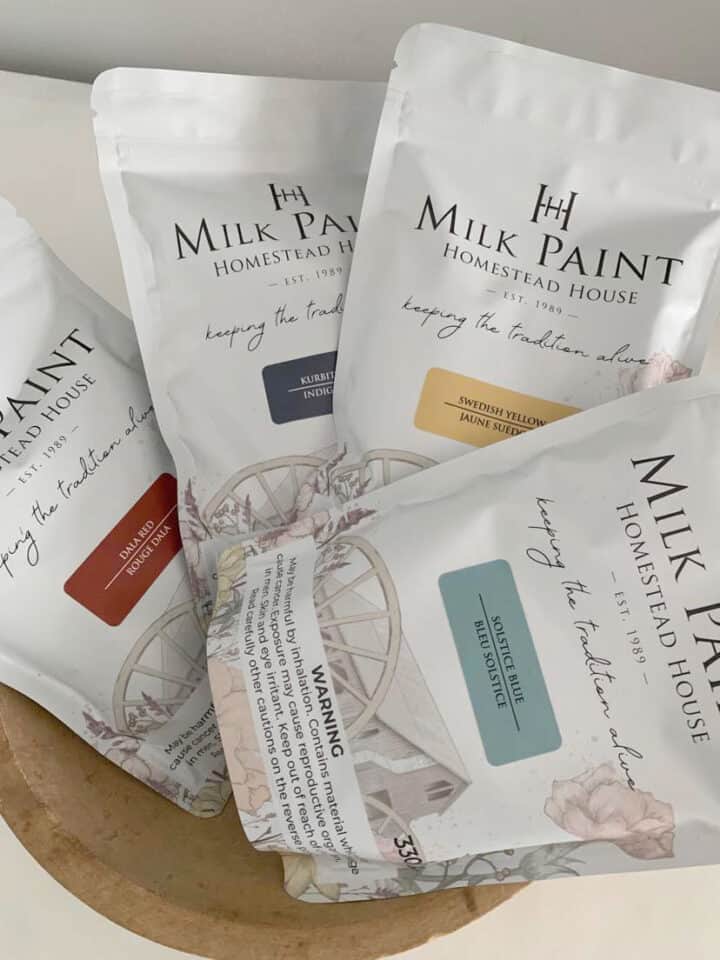Antique Paint Colors – RED
THIS LINE OF ANTIQUE PAINT COLORS IS A GREAT OPTION IF YOU’RE TRYING TO ACHIEVE AN AUTHENTIC HISTORIC LOOK ON FURNITURE!

Have you ever found an antique piece of furniture painted in a perfectly muted blue or red?
They’re always so beautiful, aren’t they? Recently I saw a primitive hutch on Facebook marketplace that had that perfectly weathered original light blue paint. Oh, how I wanted that, but it sold in what must have been seconds!
If you love those weathered old pieces of furniture in antique paint colors you’re going to be interested in my latest discovery!
Fusion Mineral Paint, a brand I use often on furniture makeovers, is now offering a line of milk paint called the Swedish collection. I noticed it on social media and it stopped me in my tracks.

It’s offered in several shades reminiscent of antique paint colors!
This I had to try for myself.
Occasionally I’ll run into problems trying to refinish an old piece, like this vintage bench makeover. When that happens I sometimes have no choice but to paint it.
I’d been leaning towards black painted furniture over white for the last year or so because it always gives a more refined look when finished. However, I do like to have other options which led me to experiment with this paint.
I haven’t had any experience with milk paint so I wanted to try it on something small and inexpensive to try it out. This little chair (not sure if it’s actually vintage, but it does look old underneath) was found for $5 at a yard sale. I thought it would make a cute plant stand but I definitely wasn’t loving the white with gray stripes.

Antique Paint Colors From Homestead House
The antique paint colors I chose to try from Homestead House (sold under Fusion Mineral Paint) are Dala Red, Solstice Blue, Kurbits Indigo, and Swedish Yellow. For this project, I used the Dala Red.

If you know me at all, you know I’m not a fan of the color red. However, this soft, very muted red is an exception.
Mixing Milk Paint
The milk paint comes in powder form. Begin by mixing equal parts of the paint powder with water.

Stir well and the powder will absorb. It will be thinner than regular paint but it shouldn’t be so thin that it will drip off your brush. You can add more water or powder until you get a good consistency.
To use the paint as a light wash or stain, use more water. For a textured effect, use more powder. I went with consistency in the middle of those two, which worked well for me.
I applied one coat and let it dry for 30 minutes as recommended before applying a second coat.

Here you can see the color as it looks when it goes on, it dries lighter than this. (My progress photos for this project aren’t great. Winter in NJ doesn’t provide much sunlight and this was a very gray day.) That said here is how the color looked after it dried.

My finish here was a little bit grainy. I think I should’ve mixed the powder better. The paint can be sanded down to a smooth finish when dry before applying the next coat.
I reached out to Fusion and they suggested letting the mix sit for about 5-10 minutes after mixing very well, as that will help the powder dissolve.
Sealing Milk Paint
Once you have your desired coverage, you have more options. You can leave it unsealed and let it chip, which it will, for a naturally distressed look.
Option two is to seal it with their furniture wax.
Lastly, you can use a hemp oil wood finish, which is what I did. Hemp oil can be used on natural wood or over milk paint. It’s used to revive and protect the wood. Over paint, it will darken it and give it a richer look as well as a light sheen. You can get a higher sheen with multiple coats.
I applied the oil with a brush. I keep a box of inexpensive chip brushes around to use for samples or experimenting.

Let it sit for 30 minutes and then buff it with a cloth. It takes 2 hours to fully cure. After the first coat is cured, you can repeat the process for a higher sheen. If you want a lower sheen, use less and buff more.
I noticed after a few days the sheen dulled some, which I liked. It looks more natural.

You can achieve several different finishes with milk paint, such as smooth, crackled, or lightly distressed. You can read more about milk paint and how to use it here.
Even though I’m not a red person, I do like this muted, historic shade. The chair (aka plant stand) looks much better now than when I found it, don’t you think?

Here’s a look at a frame I painted in the Kurbit’s blue, and the crate below it is painted Swedish Yellow. I still have to try the Solstice Blue.

Overall, I like the milk paint and really love the idea of the antique paint colors, so fun!
YOU MAY ALSO LIKE:



Nice. My favorite color was the solstice blue.